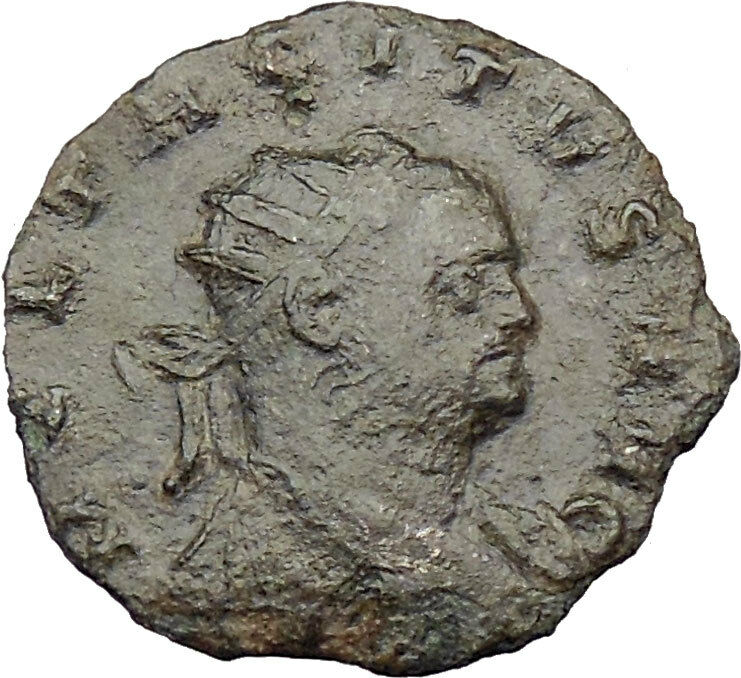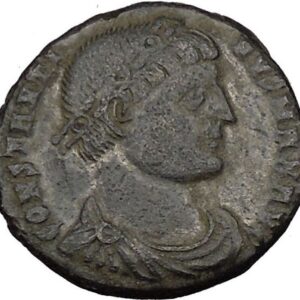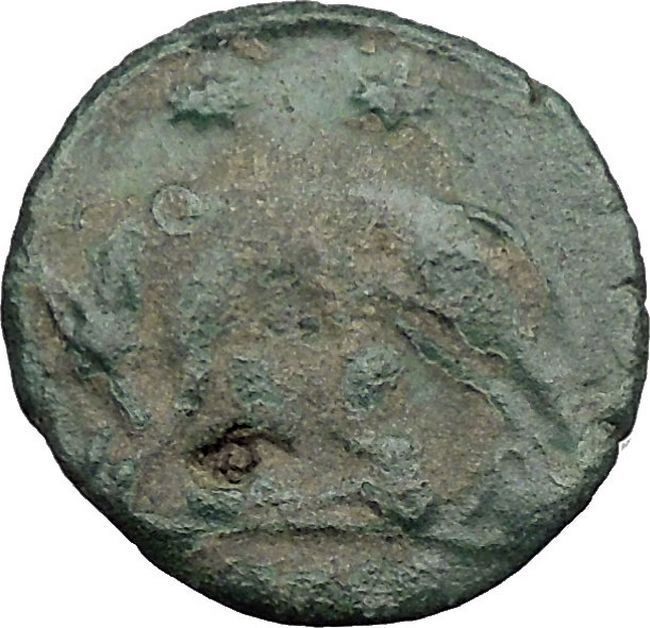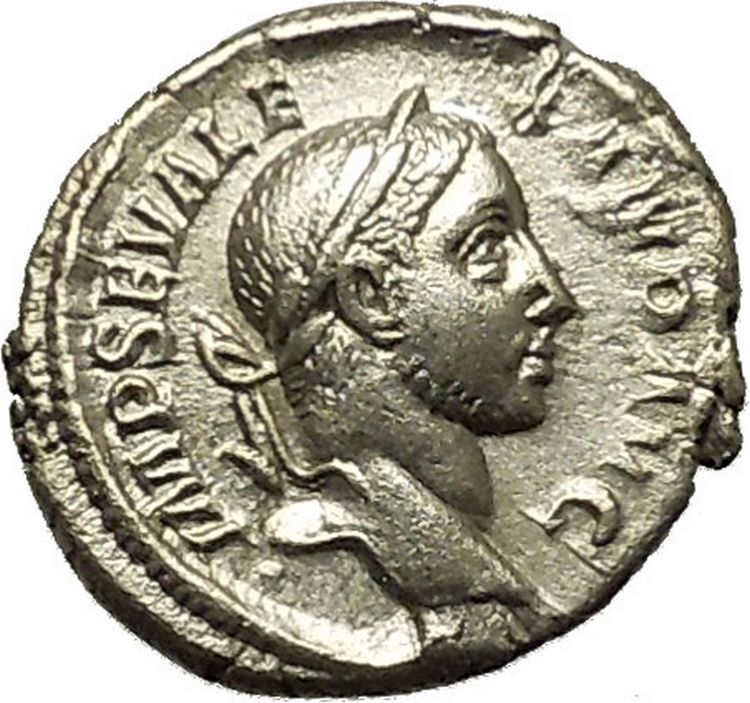|
Caracalla
–
Roman Emperor
: 198-217 A.D. –
Silver Denarius 20mm (3.36 grams) Struck circa 198-217 A.D.
Reference: RIC 22a
IMPCAESMAVRANTONAVG – Laureate, draped and cuirassed bust right.
SECVRITORBIS – Securitas seated right, resting head on hand and holding
scepter; altar in background.
You are bidding on the exact item pictured,
provided with a Certificate of Authenticity and Lifetime Guarantee of
Authenticity.
Securitas – Security, as a goddess worshipped by the Romans, is
delineated in a great variety of ways on their imperial coins. She appears
for the most part under the form of a woman in matronly costume; though in
some few instances she is but half clothed, having a veil thrown over the
lower extremities. Sometimes she is quietly seated, as if perfectly at her
ease and having nothing to fear. That is to say, her right or her left elbow
rests on her chair, and the hand supports her head, as in Nero. Or else one
of her arms is placed above the head; an attitude which ancient artists
regarded as characteristic of repose. She holds in one or other of her hands
either a sceptre, or a scipio, or the hasta pura, or a cornucopia, or a
patera, or a globe. On some medals there is near her a lighted altar; on
others she stands leaning against, or with her arm upon, a column or cippus,
having sometimes the legs crossed in a tranquil, easy posture, carrying one
of the above-mentioned symbols, or otherwise holding before her a branch or
a crown of olive, or a palm branch. The meaning of these various attitudes
and attributes is on the whole too evident to require explanation. There are
medals of nearly all the emperors (with flagrant inappropriateness to most
of the reigns) from Otho and Vitellius to Constans and Constantius jun.,
which have for the type of their reverses this figure of Security, and
present for their legend the word SECVRITAS, with the addition of the words,
AVGVSTI, or AVGVSTORVM (security of the emperor or of the emperors); ORBIS
(security of the world) ; PVBLICA (public security) ; PERPETVA (perpetual
security) ; POPVLI ROMANI (security of the Roman people) TEMPORVM (of the
Times) ; IMPERII (of the empire) SAECVLI (of the age) ; REPVBLICAE (of the
republic), etc.
In the
Roman Republic
, and later the Empire, the
curule seat (sella curulis, supposedly from currus,
“chariot”) was the chair upon which senior magistrates or promagistrates
owning imperium
were entitled to sit,
including
dictators
,
masters of the horse
,
consuls
,
praetors
,
censors
, and the
curule aediles
. Additionally, the
Flamen
of
Jupiter
(Flamen Dialis) was also allowed to
sit on a sella curulis,though this position lacked imperium.
According to Livy
the curule seat, like the
Roman toga
, originated in
Etruria
, and it has been used on surviving
Etruscan monuments to identify magistrates, but much earlier stools
supported on a cross-frame are known from the
New Kingdom of Egypt
. According to
Cassius Dio
, early in 44 BC a senate decree
granted
Julius Caesar
the sella curulis
everywhere except in the theatre, where his
gilded
chair and jeweled crown were carried
in, putting him on a par with the gods. As a form of
throne
, the sella might be given as
an honor to foreign kings recognized formally as friend (amicus) by
the
Roman people
or
senate
.
The curule chair is used on Roman medals as well as funerary monuments to
express a curule magistracy; when traversed by a
hasta
(spear), it is the symbol of
Juno
.
The curule chair was traditionally made of or veneered with
ivory
, with curved legs forming a wide X;
it had no back, and low arms. Although often of luxurious construction, the
Roman curule was meant to be uncomfortable to sit on for long periods of
time, the double symbolism being that the official was expected to carry out
his public function in an efficient and timely manner, and that his office,
being an office of the
republic
, was temporary, not perennial. The
chair could be folded, and thus an easily transportable seat, originally for
magisterial and promagisterial commanders in the field, developed a hieratic
significance, expressed in fictive curule seats on funerary monuments, a
symbol of power which was never entirely lost in post-Roman European
tradition. 6th-century consular ivory
diptychs
of Orestes and of Constantinus
each depict the consul seated on an elaborate curule seat with crossed
animal legs.
Along the
Silk Road
the folding seat of the
Eastern Roman Empire
made its way to China,
where in various forms including the hu chuang— the “barbarian bed”—
it “transformed the dress, architecture and lifestyle of the Chinese” In
Han China
the folding chair made its first
literary mark in the 2nd century AD, used out-of-doors in a military rather
than domestic setting, and from the way it was addressed in a poem by
Yu Jianwu
, written about 552
By the name name handed down you are from a foreign region
coming into [China] and being used in the capital
With legs leaning your frame adjusts by itself
With limbs slanting your body levels by itself…
it is clear the cross-framed folding seat was intended.
In Gaul the
Merovingian
successors to Roman power
employed the curule seat as an emblem of their right to dispense justice,
and their Capetian
successors retained the iconic
seat: the “Throne of
Dagobert
“, of cast bronze retaining traces
of its former gilding, is conserved in the
Bibliothèque nationale de France
. The
“throne of Dagobert” is first mentioned in the 12th century, already as a
treasured relic, by
Abbot Suger
, who claims in his
Administratione, “We also restored the noble throne of the glorious King
Dagobert, on which, as tradition relates, the Frankish kings sat to receive
the homage of their nobles after they had assumed power. We did so in
recognition of its exalted function and because of the value of the work
itself.” Abbot Suger added bronze upper members with foliated scrolls and a
back-piece. The “Throne of Dagobert” was coarsely repaired and used for the
coronation of
Napoleon
.
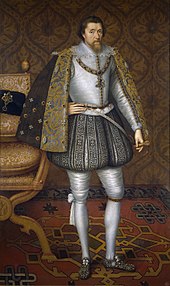
James I of England
(ruling
1603–13) with a royal cross-framed armchair and standing on an
Oriental carpet
, by
Paul van Somer

Engraving of a sealing of Peter II, ca 1196—1213
In the 15th century, a characteristic
folding-chair
of both Italy and Spain was
made of numerous shaped cross-framed elements, joined to wooden members that
rested on the floor and further made rigid with a wooden back. 19th-century
dealers and collectors termed these “Dante
Chairs” or “Savonarola
Chairs“, with disregard to the centuries intervening between the
two figures. Examples of curule seats were redrawn from a 15th-century
manuscript of the Roman de Renaude de Montauban and published in
Henry Shaw’s Specimens of Ancient Furniture (1836).
The 15th or early 16th-century curule seat that survives at
York Minster
, originally entirely covered
with textiles, has rear members extended upwards to form a back, between
which a rich textile was stretched. The cross-framed armchair, no longer
actually a folding chair, continued to have regal connotations.
James I of England
was portrayed with such
a chair, its framing entirely covered with a richly patterned
silk damask
textile, with decorative
nailing, in
Paul van Somer
‘s portrait (illustration,
left). Similar early 17th-century cross-framed seats survive at
Knole
, perquisites from a royal event.
The form found its way into stylish but non-royal decoration in the
archaeological second phase of
neoclassicism
in the early 19th century. An
unusually early example of this revived form is provided by the large sets
of richly carved and gilded pliants (folding stools) forming part of
long sets with matching tabourets delivered in 1786 to the royal
châteaux of
Compiègne
and
Fontainebleau
. With their Imperial Roman
connotations, the backless curule seats found their way into furnishings for
Napoleon, who moved some of the former royal pliants into his state
bedchamber at Fontainebleau. Further examples were ordered, in the newest
Empire taste:
Jacob-Desmalter
‘s seats with members in the
form of carved and gilded sheathed sabres were delivered to
Saint-Cloud
about 1805. Cross-framed
drawing-room chairs are illustrated in
Thomas Sheraton
‘s last production, The
Cabinet-Maker, Upholsterer and General Artist’s Encyclopaedia (1806),
and in
Thomas Hope
‘s Household Furniture
(1807).
With the decline of archaeological neoclassicism, the curule chair
disappeared; it is not found among
Biedermeier
and other Late Classical
furnishing schemes.
Caracalla (Latin:
Marcus Aurelius Severus Antoninus Augustus;4
April 188 – 8 April 217) was
Roman emperor
from 198 to 217 The eldest son of
Septimius Severus
, for a short time he ruled
jointly with his younger brother
Geta
until he had him murdered in 211.
Caracalla is remembered as one of the most notorious and unpleasant of emperors
because of the massacres and persecutions he authorized and instigated
throughout the Empire.

Caracalla’s reign was also notable for the
Constitutio Antoniniana
(also called the
Edict of Caracalla), granting
Roman citizenship
to all freemen throughout the
Roman Empire
, which according to historian
Cassius Dio
, was done for the purposes of
raising tax revenue. He is also one of the emperors who commissioned a large
public bath-house (thermae)
in Rome. The remains of the
Baths of Caracalla
are still one of the major
tourist attractions of the Italian capital.

The
Severan Tondo
Early life

|
O:
laureate
draped bust of young Caracalla
ANTONINVS
_AVGVSTVS
|
R:
Felicitas
holding
caduceus
and
cornucopia
FELICI_TAS
AVGG
|
|
silver
denarius
struck in
Rome
200; ref.: RIC 35 |
Caracalla, of mixed
Punic
–Roman
and Syrian
descent, was born Lucius Septimius
Bassianus in Lugdunum
,
Gaul (now Lyon
,
France
), the son of the later Emperor Septimius
Severus and
Julia Domna
. At the age of seven, his name was
changed to Marcus Aurelius Septimius Bassianus Antoninus to create a connection
to the family of the philosopher emperor
Marcus Aurelius
. He was later given the
Caracallanickname
,
which referred to the Gallic hooded tunic he habitually wore and which he made
fashionable.
Reign (211)
Murder of brother
(211)
His father died in 211 at
Eboracum
(now
York) while on campaign in northern Britain. Caracalla was present
and was then proclaimed emperor by the troops along with his brother
Publius Septimius Antoninus Geta
. Caracalla
suspended the
campaign in Caledonia
and soon ended all
military activity, as both brothers wanted to be sole ruler thus making
relations between them increasingly hostile. When they tried to rule the Empire
jointly they actually considered dividing it in halves, but were persuaded not
to do so by their mother.
Then in December 211 at a reconciliation meeting arranged by their mother
Julia, Caracalla had Geta assassinated by members of the Praetorian Guard loyal
to himself, Geta dying in his mother’s arms. Caracalla then persecuted and
executed most of Geta’s supporters and ordered a
damnatio memoriae
pronounced by the Senate
against his brother’s memory.
Geta’s image was simply removed from all coinage, paintings and statues,
leaving a blank space next to Caracalla’s. Among those executed were his former
cousin-wife
Fulvia Plautilla
, his unnamed daughter with
Plautilla along with her brother and other members of the family of his former
father-in-law
Gaius Fulvius Plautianus
. Plautianus had
already been executed for alleged treachery against emperor Severus in 205.
About the time of his accession he ordered the
Roman currency
devalued, the silver purity of
the denarius
was decreased from 56.5% to 51.5%, the
actual silver weight dropping from 1.81 grams to 1.66 grams – though the overall
weight slightly increased. In 215 he introduced the
antoninianus
, a “double denarius” weighing
5.1 grams and containing 2.6 grams of silver – a purity of 52%.
In the Roman provinces
In 213, Caracalla went north to the German frontier to deal with the
Alamanni
tribesmen who were raiding in the
Agri Decumates
. The Romans did defeat the
Alamanni in battle near the river
Main
, but failed to win a decisive victory over
them. After a peace agreement was brokered and a large bribe payment given to
the invaders, the Senate conferred upon him the empty title of Germanicus
Maximus. He also acquired the surname Alemannicus at this time.
The following year the tyrant traveled to the East, to Syria and Egypt never to
return to Rome.
Gibbon
in his work describes Caracalla as “the
common enemy of mankind”. He left the capital in 213, about a year after the
murder of Geta, and spent the rest of his reign in the provinces, particularly
those of the East. He kept the Senate and other wealthy families in check by
forcing them to construct, at their own expense, palaces, theaters, and places
of entertainment throughout the periphery. New and heavy taxes were levied
against the bulk of the population, with additional fees and confiscations
targeted at the wealthiest families.
When the inhabitants of
Alexandria
heard Caracalla’s claims that he had
killed Geta in self-defense, they produced a satire mocking this as well as
Caracalla’s other pretensions. In 215, Caracalla savagely responded to this
insult by slaughtering the deputation of leading citizens who had unsuspectingly
assembled before the city to greet his arrival, and then unleashed his troops
for several days of looting and plunder in Alexandria. According to historian
Cassius Dio, over 20,000 people were killed.[citation
needed]
Domestic Roman policy
Affiliation with
the army
During his reign as emperor, Caracalla raised the annual pay of an average
legionary to 675
denarii
and lavished many benefits on the
army which he both feared and admired, as instructed by his father Septimius
Severus who had told him on his deathbed to always mind the soldiers and ignore
everyone else. Caracalla did manage to win the trust of the military with
generous pay rises and popular gestures, like marching on foot among the
ordinary soldiers, eating the same food, and even grinding his own flour with
them.
With the soldiers, “He forgot even the proper dignity of his rank,
encouraging their insolent familiarity,” according to Gibbon.
“The vigour of the army, instead of being confirmed by the severe discipline of
the camps, melted away in the luxury of the cities.”

|
O:
laureate
head of Caracalla
ANTONINVS
PIVS
AVG
GERM
|
R:
Sol
holding
globe
, rising hand
P M
TR P
_XVIIII
COS
IIII
P P
|
|
silver
denarius
struck in
Rome
216; ref.: RIC 281b, C 359 |
His official portraiture marks a break with the detached images of the
philosopher–emperors who preceded him: his close-cropped haircut is that of a
soldier, his pugnacious scowl a realistic and threatening presence. This rugged
soldier–emperor iconic archetype was adopted by most of the following emperors
who depended on the support of the troops to rule, like his eventual successor
Maximinus Thrax
.
Seeking to secure his own legacy, Caracalla also commissioned one of Rome’s
last major architectural achievements, the
Baths of Caracalla
, the 2nd largest public
baths ever built in ancient Rome. The main room of the baths was larger than
St. Peter’s Basilica
, and could easily
accommodate over 2,000 Roman citizens at one time. The bath house opened in 216,
complete with libraries, private rooms and outdoor tracks. Internally it was
lavishly decorated with gold-trimmed marble floors, columns, mosaics and
colossal statuary.
Edict of
Caracalla (212)
The
Constitutio Antoniniana
(Latin: “Constitution
[or Edict] of Antoninus”) (also called Edict of Caracalla) was an edict
issued in 212 by Caracalla which declared that all free men in the Roman Empire
were to be given full Roman citizenship and all free women in the Empire were
given the same rights as Roman women.
Before 212, for the most part only inhabitants of Italia held full Roman
citizenship. Colonies of Romans established in other provinces, Romans (or their
descendants) living in provinces, the inhabitants of various cities throughout
the Empire, and small numbers of local nobles (such as kings of client
countries) held full citizenship also. Provincials, on the other hand, were
usually non-citizens, although many held the
Latin Right
.
The Roman Historian
Cassius Dio
contended that the sole motivation
for the edict was a desire to increase state revenue.At the time aliens did not have to pay most taxes that were required of
citizens, so although nominally Caracalla was elevating their legal status, he
was more importantly expanding the Roman tax base. The effect of this was to
remove the distinction that citizenship had held since the foundation of Rome
and as such the act had a profound effect upon the fabric of Roman society.[16]
War with Parthia
According to the historian Herodian, in 216, Caracalla tricked the Parthians
into believing that he accepted a marriage and peace proposal, but then had the
bride and guests slaughtered after the wedding celebrations. The thereafter
ongoing conflict and skirmishes became known as the
Parthian war of Caracalla
.
Assassination (217)
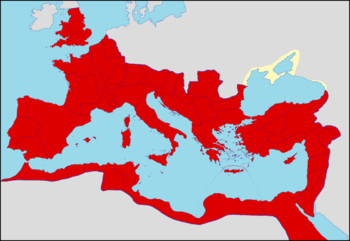
The Roman Empire during the reign of Caracalla.
While travelling from
Edessa
to continue the war with
Parthia
, he was assassinated while urinating at
a roadside near
Carrhae
on 8 April 217 (4 days after his 29th
birthday), by Julius Martialis, an officer of his personal bodyguard.
Herodian
says that Martialis’ brother had been
executed a few days earlier by Caracalla on an unproven charge; Cassius Dio, on
the other hand, says that Martialis was resentful at not being promoted to the
rank of centurion. The escort of the emperor gave him privacy to relieve
himself, and Martialis then ran forward and killed Caracalla with a single sword
stroke. While attempting to flee, the bold assassin was then quickly dispatched
by a Scythian archer of the Imperial Guard.
Caracalla was succeeded by his
Praetorian Guard Prefect
,
Macrinus
, who (according to Herodian) was most
probably responsible for having the emperor assassinated.
His nickname
According to
Aurelius Victor
in his Epitome de Caesaribus,
the agnomen
“Caracalla” refers to a Gallic
cloak
that Caracalla adopted as a personal
fashion, which spread to his army and his court.
Cassius Dio
and the
Historia Augusta
agree that his nickname was derived from his cloak, but do not mention its
country of origin.
Legendary king of
Britain
Geoffrey of Monmouth
‘s legendary
History of the Kings of Britain
makes
Caracalla a king of Britain, referring to him by his actual name “Bassianus”,
rather than the nickname Caracalla. In the story, after Severus’s death the
Romans wanted to make Geta king of Britain, but the Britons preferred Bassianus
because he had a British mother. The two brothers fought a battle in which Geta
was killed and Bassianus succeeded to the throne. He ruled until he was betrayed
by his Pictish
allies and overthrown by
Carausius
, who, according to Geoffrey, was a
Briton, rather than the historically much later
Menapian
Gaul that he actually was.
|













